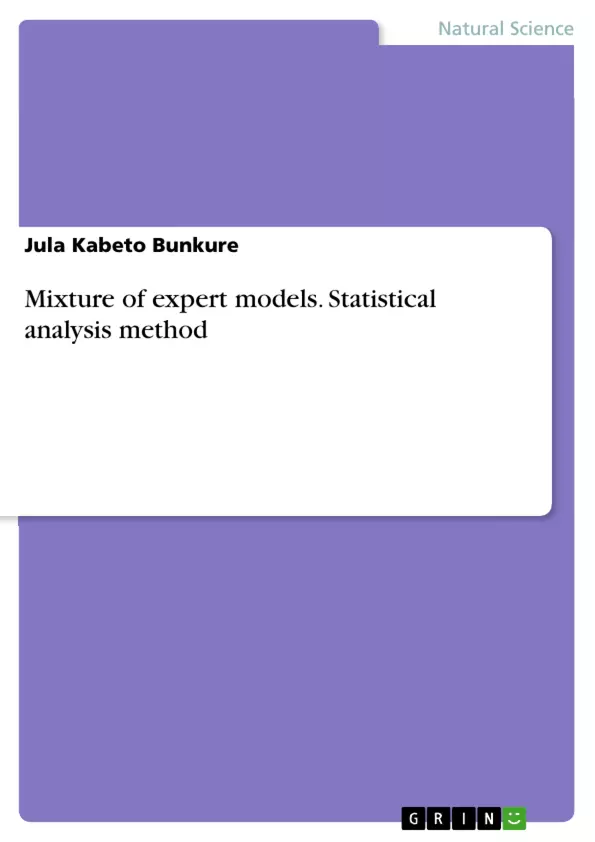Mixtures of experts models consist of a set of experts, which model conditional probabilistic processes, and a gate which combines the probabilities of the experts. The probabilistic basis for the mixture of experts is that of a mixture model in which the experts form the input conditional mixture components while the gate outputs form the input conditional mixture weights. A straightforward generalisation of ME models is the hierarchical mixtures of experts (HME) class of models, in which each expert is made up of a mixture of experts in a recursive fashion.
This principle states that complex problems can be better solved by decomposing them into smaller tasks. In mixtures of experts the assumption is that there are separate processes in the underlying process of generating the data. Modelling of these processes is performed by the experts while the decision of which process to use is modelled by the gate.
Mixtures of experts have many connections with other algorithms such as tree-based methods, mixture models and switching regression. In this, I review the paper by Rasmussen and Ghahramani to see how closely the mixtures of experts model resembles these other algorithms, and what is novel about it. The aim of this review is to adopt the method used in the current article to local precipitation data.
Inhaltsverzeichnis (Table of Contents)
- 1 Preliminary
- 2 Mixtures of Experts Model
- 2.1 The EM algorithm and mixtures of experts
- 3 Hierarchical Mixtures of Experts
- 4 Training Mixtures and Hierarchical Mixtures of Experts
- 4.1 The EM algorithm and mixtures of experts
Zielsetzung und Themenschwerpunkte (Objectives and Key Themes)
This document reviews the Mixtures of Experts (ME) model, a class of statistical models that combines multiple expert models with a gating network. The objective is to analyze how closely the ME model resembles other algorithms like tree-based methods and mixture models, highlighting its unique contributions. The review also aims to explore the application of the ME model to local precipitation data.
- Decomposition of target data into expert models and a gating network
- Probabilistic interpretation of the ME model using belief networks
- Hierarchical mixtures of experts (HME) as an extension of ME models
- Training of ME and HME models using the Expectation-Maximization (EM) algorithm
- Comparison of ME models with other algorithms and their applications
Zusammenfassung der Kapitel (Chapter Summaries)
- 1 Preliminary: This chapter introduces the concept of ME models as a combination of expert models and a gate, emphasizing the principle of decomposing complex problems into smaller tasks. It establishes the connection between ME models and other algorithms like tree-based methods, mixture models, and switching regression. The chapter then clarifies the goal of this review: to understand how ME models resemble these other algorithms and explore their potential applications.
- 2 Mixtures of Experts Model: This chapter delves into the core structure of the ME model. It introduces the decomposition of target data (Y) and input data (X) based on the hidden variable Z, representing the identity of the expert responsible for generating each data point. The chapter then explains the roles of the gate and experts in modeling the probabilistic assignment of inputs to processes and the generation of outputs, respectively. It also provides a schematic representation of the ME model with two experts and discusses the choice of expert models based on the problem.
- 3 Hierarchical Mixtures of Experts: This chapter expands on the ME model by introducing the Hierarchical Mixtures of Experts (HME) model, which uses experts that are themselves mixtures of experts. The HME model is visualized as a tree structure, with the terminal nodes (leaves) containing experts and the non-terminal nodes containing gating networks. This chapter explores the probabilistic interpretation of the HME model and its representation using belief networks and tree diagrams.
- 4 Training Mixtures and Hierarchical Mixtures of Experts: This chapter focuses on training ME and HME models using the Expectation-Maximization (EM) algorithm. It emphasizes the use of EM algorithm for problems with missing data and its application to ME models where the missing data is the identity of the expert generating the data. The chapter highlights the advantages of the EM algorithm, particularly its ability to break down the optimization process into smaller tasks for each expert and gate.
Schlüsselwörter (Keywords)
The core keywords and focus topics of this document include: Mixtures of Experts (ME), Hierarchical Mixtures of Experts (HME), probabilistic models, expert models, gating networks, belief networks, Expectation-Maximization (EM) algorithm, hidden variables, local precipitation data, and the comparison with other algorithms like tree-based methods, mixture models, and switching regression. These terms are central to understanding the ME model's structure, training, and applications.
- Quote paper
- Jula Kabeto Bunkure (Author), 2020, Mixture of expert models. Statistical analysis method, Munich, GRIN Verlag, https://www.grin.com/document/595710



